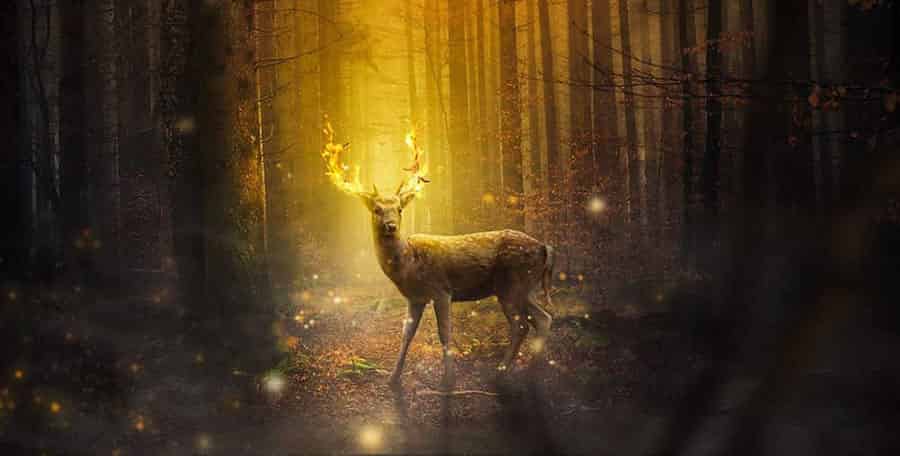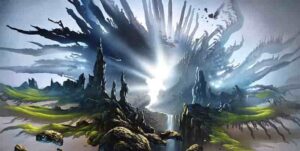To build a druid of the Circle of the Land in DnD 5e, consider the following:
- Choose a race with a Wisdom modifier, followed by Constitution or Intelligence
- Understand the basic druid build and plan to be a spellcaster
- Spells should be versatile with field manipulation and damaging options
- Choose a land and understand the circle spells
- Arctic
- Coast
- Desert
- Forest
- Grassland
- Mountain
- Swamp
- Underdark
In Dungeons and Dragons 5e, druids among the Circle of the Land are connected to specific ecosystems, offering a spread of unique character options. Each ecosystem offers the druid a unique set of spells that connect with the land thematically. Therefore, this type of character will lean into the magical side of druids, manipulating the elements and only shapeshifting when necessary.
If you’d like to try this build in a premade story, check out my pirate adventure, Dead Man’s Tale, below.
Choose a race with a Wisdom modifier, followed by Constitution or Intelligence
One of the best druid races is firbolg. With a whopping +2 Wisdom bonus, these big, goofy dudes connect with nature on another level. They’re probably the best candidate for straight-forward optimization. Plus, they come with detect magic, disguise self, a built-in invisibility move called Hidden Step. They even have the natural ability to crudely speak with plants and animals.
Of course, you can’t go wrong with a classic wood elf, who would grant an extra +2 to Dexterity along with the +1 Wisdom bonus and several innate abilities. However, a tortle could offer a +1 Wisdom with a +2 Strength bonus if being all nimble isn’t your thing.
Understand the basic druid build and plan to be a spellcaster
This character will come with basic adventure requirements: leather armor, a choice of ranged and simple melee weapons, an herbalist kit and a few proficiencies.
Naturally, this type of druid should stay out of the fray as much as possible. The leather armor only offers so much protection. A high Dexterity build can help the matter, but most druids aren’t built with Dex in mind. Lean into ranged weapons like a bow or sling or focus on spell casting and defend yourself with a shield. Again, the shield will only protect so much.
I would suggest proficiencies in Nature and Perception to add to the naturalist vibe.
Spells should be versatile with field manipulation and damaging options
This type of spellcaster relies on field manipulation mixed with damage. For druids, this looks like plant manipulation and environmental effects. My goal is to hinder the movement of my foes so that my party can have an advantage. I’ll be a support character, able to block movement, hinder senses and even heal.
As far as cantrips go, I’m definitely choosing druidcraft as a base spell. Essentially, I can manipulate plant life and tell the weather on a basic level. The forest-of-vines stuff will come later, but this basic adventure spell can do creative wonders. Also, a basic damage move like poison spray is nice to have on hand—causing a solid 1d10 poison damage.
1st level spells should include cure wounds, which heals 1d8 +Wis, and field effects like fog cloud, entangle and thunderwave. Fog cloud can hinder sight for quick escapes within a 20-foot radius. Entangle creates a 20-foot radius of thorny vines, which makes the terrain “difficult” and forces enemies to make a Strength saving check or be restrained. Thunderwave is a nice damage dealer. Everyone within a 15-foot cube is pushed 10 feet away and dealt 2d8 damage on a failed Constitution save.
2nd level spells can keep the field effect party rolling with moonbeam, spike growth and maybe animal messenger just for fun. Moonbeam drops a 2d10 radiant ray of light on the field, with the ability to be moved around like a laser-guided satellite weapon. Spike growth is the next evolution of entangle, spreading in a 20-foot radius and dealing 2d4 damage for every 5 feet traveled in the area. I chose animal messenger as an example of off-beat selections that make creative solutions.
Related Posts:
Guide to Building a Druid Circle of Spores: DnD 5e
| Guide to Building a Druid Circle of Fire: DnD 5e
|
Choose a land and understand the circle spells
Now that we have our basic druid ready to roll, it’s time for some character customization. As a Circle of the Land druid, I’ll choose an environment that relates to me—and gain a bonus cantrip. I could be a classic forest druid or something bizarre like a desert druid. The list is as follows:
- Arctic
- Coast
- Desert
- Forest
- Grassland
- Mountain
- Swamp
- Underdark
Each environment listed comes with bonus spells attached. As far as gameplay goes, I like to lean into this element of my druid. This means my animal forms may relate to my homeland, or it might affect my spell list. Creativity is brewing here if we lean into the story. Let’s start with a weird one.
Arctic
Arctic druids prefer polar animals like bears, wolves, snow owls and seals, as well as icy terrains. They receive hold person and spike growth at level 3. I like to think of hold person in a sense of freezing an enemy’s movements, perhaps turning their skin blue. The spike growth spell might sound strange at first, but I can imagine the thorns as pine needles. This area-of-effect spell causes 2d4 piercing per 5 feet of movement.
Level 5 adds sleet storm and slow into the mix, leaning into the arctic theme heavily. Sleet storm creates difficult, icy terrain in an area 20 feet tall with a 40-foot radius. Foes who enter this area must make a Dexterity save or fall prone. Fires are immediately doused. Slow, which halves enemy speed and gives -2 penalty to AC and Dex saves, and hold person are similar “freezing” spells. I think of blizzards slowing progress or something slowly freezing in place.
Level 7 adds freedom of movement and ice storm to my readied spells. Freedom of movement allows me or an ally to ignore difficult terrain, paralyzing effects, and restraint. Plus, the target can spend 5 feet of movement to escape nonmagical restraints such as manacles or grappling and ignore penalties to underwater movement. Ice storm creates a similar storm cone as sleet storm but deals 2d8 bludgeoning damage and 2d4 cold damage on failed Dexterity saves. Gnarly.
Finally, level 9 allows me to use commune with nature and cone of cold. Commune with nature offers knowledge of the land within 3 miles. Cone of cold causes creatures within a 60-foot cone to make a Constitution saving throw or take 8d8 cold damage.
Check out a complete build here.
Coast
Druids of the coast are beach dwellers and island hoppers, shifting into reef sharks and communing with the misty ocean. Level 3 adds the spells mirror image and misty step, two elusive tricks. Mirror image conjures illusory duplicates of myself, and misty step allows me to effectively teleport 30 feet away.
At level 5, my coastal druid receives water breathing and water walk. These spells are self-explanatory and make this druid perfect for ocean adventures of every kind.
Control water and freedom of movement come at level 7. Freedom of movement will aid your allies both in the water and through jungle islands, while control water adds an incredibly useful list of benefits. This list includes creating floods, redirecting flows, creating whirlpools and parting the sea like Moses.
Finally, level 9 adds conjure elemental and scrying. Conjure elemental allows me access to more than just water elementals—I can summon an elemental of fire, wind, earth or water. The difficulty level of the summoned creature must be 5 or lower. Scrying is like an enhanced commune with nature, giving more detail about a specific target. It’s like tracking a target with a psychic link.
Desert
Desert druids could be experts in giant spider or snake shifting—maybe a desert owl or predator of northern Africa. Their Circle spells focus on surviving arid climates, possibly acting as guides in desert adventures. They carry a wisdom that comes with the blowing winds and sand.
Level 3 grants these druids the spells blur and silence. Blur is an illusory spell that creates a mirage effect over my body, forcing foes to take attack rolls with disadvantage. Silence is a field effect spell that eradicates all sound within a 20-foot radius—a handy sneaking tool.
At level 5, I’ll receive create food and water and protection from energy. Although these spells may sound lame, they’re fantastic for adventures. Create food and water is self-explanatory, and helpful in a desert—where foraging is going to be difficult. Protection from energy offers elemental resistance to me or an ally, covering acid, cold, fire, lightning and thunder.
Level 7 adds blight and hallucinatory terrain. Blight is a hardcore, necromantic spell that drains moisture from a victim and does 8d8 necromantic damage. We’re talking mummy sorcerer stuff now. Hallucinatory terrain is a massive illusion spell that covers a 150-foot cube of land and transforms it. Desserts can be made to look like oceans and paths can be wiped from an enemy’s senses.
Finally, level 9 adds insect plague and wall of stone—we’re talking Bible stories and pyramids now! Insect plague covers a 20-foot sphere in biting insects, obscuring the sight of the enemies inside and dealing 4d10 on a failed Constitution save. Wall of stone creates a wall from the earth that is 6 inches thick with ten 10-by-10 foot-panels
Forest
Here, we have the classic druid. This guy is the bear-shifting lover of trees and vines and squirrels. You know what’s up.
Level 3 grants the forest druid barkskin and spider climb—a fantastic tree-related first batch of spells. Barkskin allows me to touch an ally or cast on myself an armor class buff. The AC of the target can’t be less than 16. Spider Climb is essentially Spiderman wall-crawling powers for 1 hour.
Level 5 adds area effects to my repertoire with call lightning and plant growth. Call lightning creates a storm cloud with a 60-foot radius, targeting an enemy and those within 5 feet of the enemy. This deals 3d10 damage on a failed Dexterity save and half as much on a successful save. Plant growth, as I mentioned before, is great for preventing movement of enemies.
At level 7, this druid will add divination and freedom of movement to the list. Divination is essentially asking the gods for help, which is granted to some degree. Once again, freedom of movement offers the party an advantage through my messy vines.
However, level 9 offers me an advantage of movement no one else has. Tree Stride essentially transforms any given tree into a teleportation machine. I’ll step inside the tree and come out of another tree with 500 feet. Of course, I’ll also gain the commune with nature spell. The forest is my domain!
Grasslands
Grassland druids are savanna or plains dwellers who take on large beast forms and are in touch with the wind and expansive earth.
Like the wind itself, grassland druids receive the spells invisibility and pass without trace at level 3. I guess there’s few places to hide in the wide open, so invisibility refracts the light around me. Pass without trace is an ability that covers my whole party, allowing all of us to be stealthy.
The next two spells that come at level 5 are daylight and haste. Firstly, daylight creates a massive lighting effect, with a 60-foot radius sphere of bright light. Then, the sphere sheds dim light for another 60 feet. It’s like creating a little sun. Haste taps into that bullish nature of the grasslands, causing a target to get juiced up for an attack. A willing ally gains double speed, +2 AC, advantage on Dexterity saving throws and an additional action. The only drawback is exhaustion on the next turn.
Level 7 adds in divination and freedom of movement. Once again, this druid offers aid to the party through difficult terrain. And once again, the druid can speak with a nature god for particular information.
With level 9, we wrap up the grassland Circle Spells with dream and insect plague. Dream is an interesting choice, as it manipulates others dreams to various effects. The vibe for this spell seems to pull from plains Indians and Native American traditions. However, insect plague is more of a horrifying, brutal reality of grassland ecology. Reminder, that’s a 20-foot sphere of 4d10 biting insects.
Mountain
Mountain druids connect deeply with the element of earth, shifting into powerful bears or burrowing giant badgers. These kinds of druids could work well with a strength-based spellcaster build, which is unusual but interesting. I could see a cool firbolg mountain druid.
The first two spells granted at level 3 are spider climb and spike growth. Of course, spider climb is natural as a rock-climbing mountaineer. Spike growth is a nasty field effect move spreading thorns across the ground in a 20-foot radius. Targets caught in the area of effect take 2d4 piercing damage for every 5 feet traveled.
Then, the real mountain magic happens at level 5 with lightning bolt and meld into stone. Lightning bolt is built for battle, dealing 8d6 on a failed Dexterity save and setting flammable objects on fire. Meld into Sone is a concealing spell that allows the caster to magically step inside a stone wall. The spellcaster can see or hear too well but is protected from some damage. If a hole is blown into the wall, the caster can be expelled with 6d6 bludgeoning damage. So, be careful.
We lean into the stone theme at level 7 with stone shape and stone skin. Stone shape allows the caster to manipulate stone objects and natural features. However, stoneskin offers the target of the spell resistance to nonmagical bludgeoning, piercing and slashing damage.
Finally, level 9 enhances the stone manipulating with passwall and wall of stone. As with the desert druid, wall of stone is an excellent defensive spell of ten 10-by-10 blocks 6 inches thick. However, passwall is about creating openings through stone structures, such as castle walls or caves.
Swamp
Swamp terrains offer a slightly darker twist on the typical druid. I like to imagine amphibious races like Mogogol frog people or a strange mushroom man Myconid.
Firstly, they learn darkness and Melf’s acid arrow, two creepy spells. Darkness spreads a 15-foot radius of utter darkness. The space is unable to be lit accept by magical means. Melf’s acid arrow is more of a combat spell, dealing 4d4 acid damage immediately and 2d4 acid damage after the target’s next turn.
Then, at level 5, I’ll gain water walk and stinking cloud—how swampy. Again, the water walk is self-explanatory. However, stinking cloud could use some explaining. Creatures caught inside the 20-foot radius of stank must make a Constitution saving throw or spend the turn retching.
With level 7, the spells are freedom of movement and locate creature. We can move and groove through the swamp and can track targets with magical means.
The final spells at level 9 include insect plague and scrying. Yikes, again with the 4d10 insect cloud. The scrying seems like a carry-over from the coastal druid, but it’s still a handy locate spell.
Underdark
One of the strangest environments on the list, the Underdark is a subterranean world of utter darkness. Druids of the Underdark may be drow or some other darker race. I like to think of a drow shifting into the underground lizards and spiders—perhaps a burrowing creature or two.
At first, the Underdark druid learns spider climb and web. These spells obviously play off the spider goddess Lolth, and I’m here for the creep factor. Spider climb is always handy. Frankly, it’s just fun to Spiderman around the area. Speaking of Spiderman, I’ll also learn Web, which covers a 20-foot area with sticky webs. Creatures who start the turn in this area must make a Dexterity save or be restrained.
I’m pretty sure this is Spiderman.
At level 5, it gets a little less superhero with gaseous form and stinking cloud. Again, stank cloud is an area effect that makes opponents puke. However, gaseous form can cause me or an ally to slip through material objects and have resistance against nonmagical attacks. On top of this, I’ll have a flying speed of 10 feet and advantage against Strength, Dexterity and Constitution checks.
Level 7 will add greater invisibility and stone shape to the roster. Greater invisibility is like an enhanced invisibility, offering the protection to an ally. Stone shape can help manipulate the surrounding rock within this environment.
Finally, level 9 offers cloudkill and insect plague. This is where the Underdark gets nasty. Cloudkill creates a noxious gas cloud 20 feet in radius. Creatures who start their turn here receive 5d8 poison damage on a failed Constitution save. And, again, INSECTS.
Related Posts:
Guide to Building a Druid Circle of Stars: DnD 5e
| Guide to Building a Wood Elf Character: DnD 5e
|






